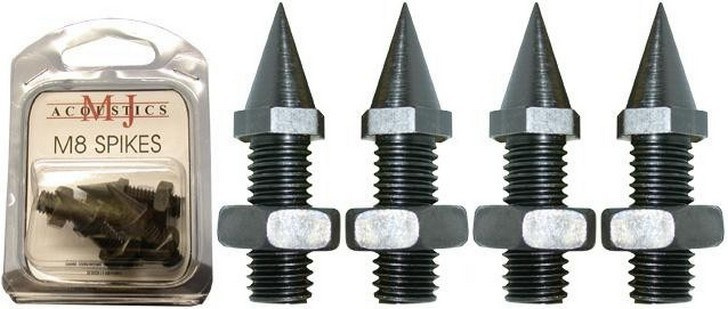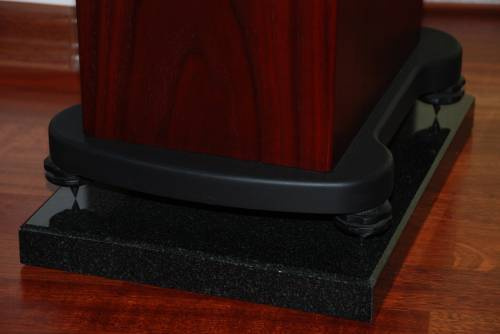Ed about spikes, or why reducing the footprint does not dampen resonances
The reason for this publication was the discussion of thorns after our last article on the Neat IOTA Alpha. So some readers argued (supplying comments with proofs) that using spikes as a junction between the speaker system and the floor suppresses parasitic resonances, thus significantly improving the sound of the speaker system.

This conventional notion is rooted in the minds of many audiophiles and music lovers, who, without wasting time, rushed to acquire the peaked stand for the speakers, hoping to get "that" divine sound (tm) without parasitic harmful resonances. However, everything turned out to be somewhat more difficult than simply buying spikes and screwing them to the system, since they (spikes) do not quench anything and do not eliminate them. The reduction of the support area, of course, repeatedly increases the pressure at the points of contact with the floor, while the vibration energy remains almost unchanged and is perfectly transmitted to the floor. What is the reason why this is happening and how can the spikes be made to work further.
In fairness, I want to note that under certain conditions, spikes begin to work as a “sound enhancer”, but this requires not only spikes and they are not a vibration isolator. That is why a number of comrades who write about the "studded" effect on the forums do not always lie and are mistaken. In order to understand what and how, it makes sense to consider both the pseudoscientific views themselves about the influence of thorns, and a completely scientific justification of how they can work.
Traditionally, a little mythology and humor.
')
In fact, speaker spikes appeared in medieval Scandinavia around the 9th century AD. Severe Vikings intuitively felt that such an approach would allow them to get rid of parasitic resonances, eliminate the vibration of the Drakkar’s body when listening to pagan metal and combat drums.

Among the references to thorns, a fragment of thematic edda is preserved. I cite a small excerpt from this work:
Listen to me all the sacred births,
Great with little children of Heimdall,
Oh, One, I will tell them about the past of thorns,
What forged Volund for the joy of mortals.
At the beginning of time when Ymir lived,
There were no speaker spikes in the world,
And music sounds and the power of resonance,
Drakkary on campaigns forced to pop.
Splitting the boat that sound parasitic,
And the brave warriors went to Hel,
Until the great god Velund came up,
Thorns that will relieve from harmful vibrations.
It appears from edda that the miraculous properties of thorns were attributed to the great blacksmith god Velund. From the experience of the ancient Scandinavians, their modern followers concluded:
Quote: User Ancient User - audioportal.hi-fi.ru)

But jokes are jokes, but seriously, the theory that justifies the anti-vibration effect of spikes, says that reducing the area of contact with the surface can reduce resonances. At the same time, the fundamental law of conservation of energy disappears somewhere from the reasoning of such a plan, which says, among other things, that energy (any) does not disappear anywhere. The spike is solid and, accordingly, is an excellent conductor of vibration.
Roughly speaking, the only thing that makes a spike with resonances is that it concentrates the energy of vibration (resonance) at the points of contact of the spike with the floor, and this essentially does not change anything, since the same amount of energy is transmitted to the floor (more on energy density here ).
At the same time, a number of manufacturers of such products recommend installing them on the so-called “pyataks” (holders with indentations). Stands are made of metals with a density lower than that of spikes (the latter, as a rule, are made from hardened steel). Such a solution, from the point of view of physics, has insignificant vibration-proof properties; relatively soft metals (copper, aluminum) are able to partially absorb resonances due to shear deformation.

However, the effect of “pennies” is largely due to the use of special thick lining on the bottom (which are made like standard speaker legs made of silicone, felt or PVC). In fact, the main link damping vibrations in such situations is the elastic absorber, i.e. the same felt or silicone that has a significantly greater shear strain than metals.
The path of the resonance energy can be represented as follows: a spike made of hard metal - a conductor of vibration, a "penny" of soft metal - partial absorption, an elastomer - a significant absorption. Such a system will really work, but I still do not understand why there are 2 first links in it. When using this design, many people subjectively note significant changes in the sound (it remains unclear, the comparison was made with bare spikes or with standard speaker feet).
The most effective method of anti-vibration application of thorns from all the techniques that are True from the point of view of the philophonic philosophy (audiophilia) is the use of a massive base (stone slabs, etc.). The use of a heavy base is justified by the fact that it is indeed capable of effectively suppressing high-frequency vibrations. This is especially true for speakers with a relatively small own weight.

In this case, as in all previous ones, spikes are used as a conductor of vibration, a massive granite or marble slab acts as an absorber. It should also be noted that in this way high-frequency vibrations are absorbed, and for low-frequency vibrations it makes sense to place felt under the slab. If you have a stone floor, then the purchase of plates for you is not relevant.
Spikes, as well as coasters of other shapes, can “help” the sound in situations when it is necessary that the speaker mounted on the bottom of the speaker does not rub against the suspensions of the diffuser on the floor, for example, or when for one reason or another you just need to understand the speaker to a certain height.
Spikes as an vibrating absorber (insulator) never work, due to the fact that they cannot, due to fundamental physical laws, reduce the amplitude of vibrational vibrations, but can be used in a system that will act as a floor isolation from one way or another. .
For those who are aware of the need for thorns , as well as for lovers of the Scandinavian epic and in our catalog, goods of such a profile are stored (thorns, pentads) at various prices from 119 rubles to $ 50-60. Meanwhile, we want to emphasize that the manufacturers of acoustic systems that are represented in our catalog take a serious approach to the creation of equipment. This means that the speakers sold by us are fully ready for full-fledged use (reproduction of high-quality sound) and do not require additional modifications.

This conventional notion is rooted in the minds of many audiophiles and music lovers, who, without wasting time, rushed to acquire the peaked stand for the speakers, hoping to get "that" divine sound (tm) without parasitic harmful resonances. However, everything turned out to be somewhat more difficult than simply buying spikes and screwing them to the system, since they (spikes) do not quench anything and do not eliminate them. The reduction of the support area, of course, repeatedly increases the pressure at the points of contact with the floor, while the vibration energy remains almost unchanged and is perfectly transmitted to the floor. What is the reason why this is happening and how can the spikes be made to work further.
In fairness, I want to note that under certain conditions, spikes begin to work as a “sound enhancer”, but this requires not only spikes and they are not a vibration isolator. That is why a number of comrades who write about the "studded" effect on the forums do not always lie and are mistaken. In order to understand what and how, it makes sense to consider both the pseudoscientific views themselves about the influence of thorns, and a completely scientific justification of how they can work.
Spit Velva
Traditionally, a little mythology and humor.
')
In fact, speaker spikes appeared in medieval Scandinavia around the 9th century AD. Severe Vikings intuitively felt that such an approach would allow them to get rid of parasitic resonances, eliminate the vibration of the Drakkar’s body when listening to pagan metal and combat drums.

Among the references to thorns, a fragment of thematic edda is preserved. I cite a small excerpt from this work:
Listen to me all the sacred births,
Great with little children of Heimdall,
Oh, One, I will tell them about the past of thorns,
What forged Volund for the joy of mortals.
At the beginning of time when Ymir lived,
There were no speaker spikes in the world,
And music sounds and the power of resonance,
Drakkary on campaigns forced to pop.
Splitting the boat that sound parasitic,
And the brave warriors went to Hel,
Until the great god Velund came up,
Thorns that will relieve from harmful vibrations.
It appears from edda that the miraculous properties of thorns were attributed to the great blacksmith god Velund. From the experience of the ancient Scandinavians, their modern followers concluded:
In order to reduce as much as possible the transmission of vibration of the acoustic design of the speaker to objects in contact with it (ceilings of the room, shelves, for example). The effect of the use of thorns is based on a radical decrease in the area of the contacting surfaces, which is reduced to the area of the tip of the thorns / cones. It is important to understand that the installation of speakers on the spikes does not eliminate the vibration of the case, but only reduces the effectiveness of their further propagation.
Quote: User Ancient User - audioportal.hi-fi.ru)

The song of the heels and the stone slabs
But jokes are jokes, but seriously, the theory that justifies the anti-vibration effect of spikes, says that reducing the area of contact with the surface can reduce resonances. At the same time, the fundamental law of conservation of energy disappears somewhere from the reasoning of such a plan, which says, among other things, that energy (any) does not disappear anywhere. The spike is solid and, accordingly, is an excellent conductor of vibration.
Roughly speaking, the only thing that makes a spike with resonances is that it concentrates the energy of vibration (resonance) at the points of contact of the spike with the floor, and this essentially does not change anything, since the same amount of energy is transmitted to the floor (more on energy density here ).
At the same time, a number of manufacturers of such products recommend installing them on the so-called “pyataks” (holders with indentations). Stands are made of metals with a density lower than that of spikes (the latter, as a rule, are made from hardened steel). Such a solution, from the point of view of physics, has insignificant vibration-proof properties; relatively soft metals (copper, aluminum) are able to partially absorb resonances due to shear deformation.

However, the effect of “pennies” is largely due to the use of special thick lining on the bottom (which are made like standard speaker legs made of silicone, felt or PVC). In fact, the main link damping vibrations in such situations is the elastic absorber, i.e. the same felt or silicone that has a significantly greater shear strain than metals.
The path of the resonance energy can be represented as follows: a spike made of hard metal - a conductor of vibration, a "penny" of soft metal - partial absorption, an elastomer - a significant absorption. Such a system will really work, but I still do not understand why there are 2 first links in it. When using this design, many people subjectively note significant changes in the sound (it remains unclear, the comparison was made with bare spikes or with standard speaker feet).
The most effective method of anti-vibration application of thorns from all the techniques that are True from the point of view of the philophonic philosophy (audiophilia) is the use of a massive base (stone slabs, etc.). The use of a heavy base is justified by the fact that it is indeed capable of effectively suppressing high-frequency vibrations. This is especially true for speakers with a relatively small own weight.

In this case, as in all previous ones, spikes are used as a conductor of vibration, a massive granite or marble slab acts as an absorber. It should also be noted that in this way high-frequency vibrations are absorbed, and for low-frequency vibrations it makes sense to place felt under the slab. If you have a stone floor, then the purchase of plates for you is not relevant.
And a little more about using spikes.
Spikes, as well as coasters of other shapes, can “help” the sound in situations when it is necessary that the speaker mounted on the bottom of the speaker does not rub against the suspensions of the diffuser on the floor, for example, or when for one reason or another you just need to understand the speaker to a certain height.
Total
Spikes as an vibrating absorber (insulator) never work, due to the fact that they cannot, due to fundamental physical laws, reduce the amplitude of vibrational vibrations, but can be used in a system that will act as a floor isolation from one way or another. .
For those who are aware of the need for thorns , as well as for lovers of the Scandinavian epic and in our catalog, goods of such a profile are stored (thorns, pentads) at various prices from 119 rubles to $ 50-60. Meanwhile, we want to emphasize that the manufacturers of acoustic systems that are represented in our catalog take a serious approach to the creation of equipment. This means that the speakers sold by us are fully ready for full-fledged use (reproduction of high-quality sound) and do not require additional modifications.
Source: https://habr.com/ru/post/370567/
All Articles